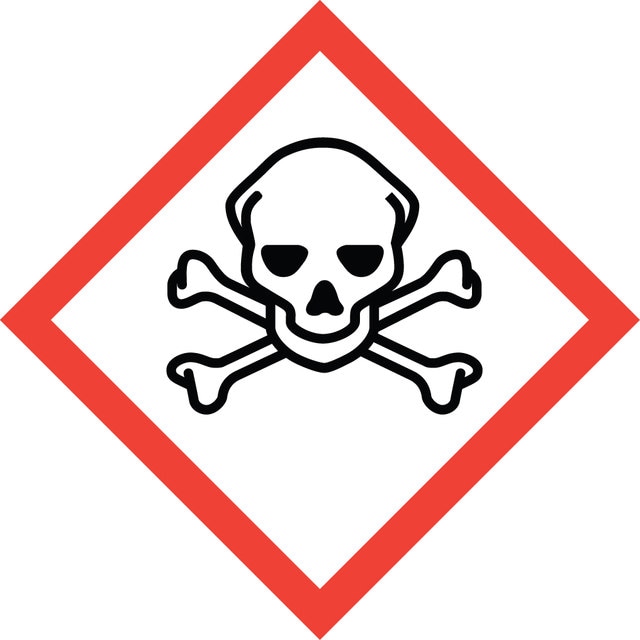Sign In to View Organizational & Contract Pricing
Select a Size
About This Item
Empirical Formula (Hill Notation):
C12H10F3N3O4
CAS Number:
Molecular Weight:
317.22
MDL number:
UNSPSC Code:
51111800
PubChem Substance ID:
NACRES:
NA.77
form
solid
originator
Sanofi Aventis
SMILES string
CC1(C)NC(=O)N(c2ccc(c(c2)C(F)(F)F)[N+]([O-])=O)C1=O
InChI
1S/C12H10F3N3O4/c1-11(2)9(19)17(10(20)16-11)6-3-4-8(18(21)22)7(5-6)12(13,14)15/h3-5H,1-2H3,(H,16,20)
InChI key
XWXYUMMDTVBTOU-UHFFFAOYSA-N
Gene Information
human ... AR(367)
Looking for similar products? Visit Product Comparison Guide
Application
Nilutamide has been used:
- as a nuclear androgen receptor (nAR) inhibitor to study its effects on oocyte maturation in zebrafish
- to determine its effects on bioluminescent Saccharomyces cerevisiae bioreporters in BLYAS assay
- as a substrate in hydrogenation reaction
Biochem/physiol Actions
Nilutamide is a nuclear androgen receptor inhibitor. It is a nonsteroidal antiandrogen that competitively inhibits the binding of dihydrotestosterone to the androgen receptor. Nilutamide shows a therapeutic effect against prostate cancer.
Features and Benefits
This compound is featured on the Nuclear Receptors (Steroids) page of the Handbook of Receptor Classification and Signal Transduction. To browse other handbook pages, click here.
This compound was developed by Sanofi Aventis. To browse the list of other pharma-developed compounds and Approved Drugs/Drug Candidates, click here.
Signal Word
Danger
Hazard Statements
Precautionary Statements
Hazard Classifications
Acute Tox. 3 Oral - Repr. 1B
Storage Class Code
6.1C - Combustible acute toxic Cat.3 / toxic compounds or compounds which causing chronic effects
WGK
WGK 3
Flash Point(F)
Not applicable
Flash Point(C)
Not applicable
Personal Protective Equipment
dust mask type N95 (US), Eyeshields, Gloves
Choose from one of the most recent versions:
Already Own This Product?
Find documentation for the products that you have recently purchased in the Document Library.
Masayasu Urushibara et al.
The Prostate, 67(8), 799-807 (2007-03-22)
Molecular basis for secondary antiandrogen therapy in prostate cancer with mutant androgen receptors (ARs) is not fully elucidated. Effects of steroidal and non-steroidal antiandrogens on transcriptional activities of wild-type and mutant (W741C, T877A, and W741C+T877A) ARs were measured. Crystal structure
Jennifer Keiser et al.
The Journal of antimicrobial chemotherapy, 65(9), 1991-1995 (2010-06-26)
The antischistosomal properties of the marketed antiandrogens bicalutamide, flutamide, nilutamide and cyproterone acetate were studied both in vivo and in vitro. Schistosoma mansoni-infected mice were treated orally with 50-400 mg/kg of the antiandrogens 3 and 7 weeks post-infection. In addition
Rajenahally V Jagadeesh et al.
Nature protocols, 10(4), 548-557 (2015-03-06)
In this protocol, we describe the preparation of nanoscale iron oxide-based materials and their use in the catalysis of different hydrogenation reactions. Pyrolysis of a Fe(OAc)2-phenanthroline complex on carbon at 800 °C under argon atmosphere results in the formation of
A Desai et al.
Urology, 58(6), 1016-1020 (2001-12-18)
To study the ability of nilutamide to induce prostate-specific antigen (PSA) responses in patients with hormone-resistant prostate cancer who had been exposed to prior antiandrogen therapy, because resistance to antiandrogens may be mediated by altered binding to a mutated or
Chih-Yang Chang et al.
Fertility and sterility, 85 Suppl 1, 1195-1203 (2006-04-18)
To investigate the effects of androgen and antiandrogen and the expression of androgen receptor on mouse embryonic stem cells (ESCs) and the inner cell mass. Controlled laboratory study. Academic university hospital. Blastocysts from mice developed at the Institute for Cancer
Our team of scientists has experience in all areas of research including Life Science, Material Science, Chemical Synthesis, Chromatography, Analytical and many others.
Contact Technical Service
